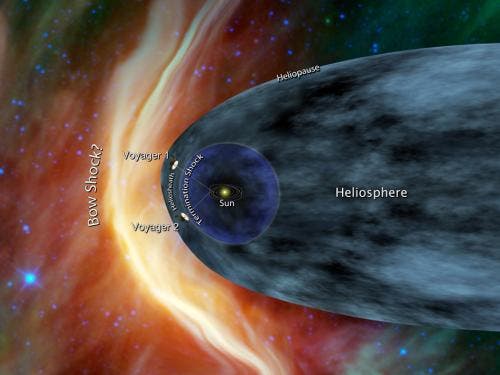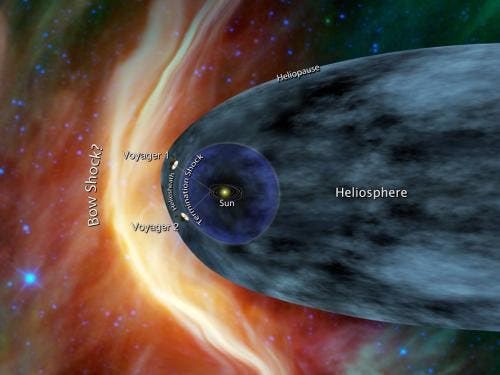
Launched in in the late 1970’s in a mission to study the planets Jupiter, Saturn and their respective satellites, the two Voyager probes have been most certainly put to a more pioneering goal and sent into outer space after having completed their last missions. Currently, Voyager-1 is the most distant human-made object from Earth and is now quite ready the break the barrier that separates our solar system from interstellar space.
Right now, Voyager is at the so called ‘heliosheath‘ limit, a boundary layer where particles streaming from the Sun clash with the gases of the galaxy.
“We’re in this mixed-up region where the Sun still has some influence,” says Stamatios Krimigis, a physicist at the Applied Physics Laboratory of Johns Hopkins University in Laurel, Maryland. “It’s certainly not what we thought.”
Scientists caught off guard by mixed space environment
Starting from December 2010, reports have indicated that the outward speed of the charged particles streaming from the sun have slowed to almost zero, something entirely unexpected by scientists. This stagnation has continued well thought out February 2011, which physicists now believe this to be a thick “transition zone” at the edge of our solar system. This boundary has caught everybody by surprise, since not even a theory was formulated in which interstellar gases mix with almost zero velocity sun particles. Krimigis says it may even be possible that this is, in fact, what interstellar space looks like.
“We may have crossed and don’t know it, because nobody has a model that describes what we’re seeing,” he says.
Voyager-1 should break into interstellar space at any time, computations show
To better understand what kind of environmnet Voyager-1 is heading through, Krimigis and colleagues combined this new Voyager data with similar measurements from the ion and neutral camera on Cassini’s magnetospheric imaging instrument, which collects data on neutral atoms streaming into our solar system from the outside.
What preliminary computations on the data shows is that the boundary layer between interstellar flight and the “solar system bubble” is likely somewhere between 10 and 14 billion miles from the Sun, most likely 11 million miles. Voyager is already 11 billion miles in, which means it could cross into interstellar flight at any time from now on.
“These calculations show we’re getting close, but how close? That’s what we don’t know, but Voyager 1 speeds outward a billion miles every three years, so we may not have long to wait,” said Ed Stone, Voyager project scientist, based at the California Institute of Technology in Pasadena.
MORE RELATED: Harvesting gas from Uranus could power interstellar flight
Soon enough, indeed, Voyager-1 will become the first man made object to completely leave our solar system, and travel far enough as it can. It’s plutonium power plant will allow it to operate smoothly until at least 2020, and “we will continue to be taking data”, says Krimigis. Even well before 2020, it will be able to continue its space journey. It is expected to pass the constellation Camelopardalis in around 40,000 years.
Voyager-1’s sister probe, Voyager-2, is currently lagging behind about 2 billion miles but it will also most certainly reach the interstellar barrier in about 6 years.
The new findings have been reported by Krimigis and his colleagues in this week’s edition of Nature.









